Sonee Singh's Blog, page 3
February 15, 2024
How I Discovered I Am a Poet

I didn’t think I had it in me to write poetry. I had read poetry for years and appreciated it, but didn’t feel it was something I could do. I now have three books of poetry and counting.
Everything changed when COVID hit and we went into lockdowns. I had been writing morning pages for a few years, but something about being isolated led me to embrace self-reflection through writing. I would review what I'd written and realize it sounded lyrical. When I rewrote my sentences into stanzas, I realized I’d written a poem.
Once I opened to the process, poems came to me throughout the day and I wrote and wrote and wrote. I accumulated so many, that I posted them on social media as a way of sharing my writing and my feelings. I am not one to express emotion readily and when they emerged in my writing, it was extremely cathartic.
On a deeper level, allowing myself to express emotion brought a great amount of healing to my body. When we hold emotions they show up as aches, pains, and illness. The moment I started to write down my emotions, I released them. As they came out on paper, so did the pain. Writing out what was happening and what I was feeling, helped me be in the moment and allowed emotions to rise. When I opened that door, the floodgates were released. More and more poems came to me.
I didn't what to do with the poems, and collected papers in a pile on my desk. I had all types of paper, including napkins, notepads, sticky notes, and scraps.
I shared these with Karen Weaver, whom I had met at a Serenity Press Retreat at Crom Castle in Northern Ireland in September 2019. We bonded at the retreat and kept in touch. She has a publishing empire, so it came as no surprise that when I shared I had accumulated all this poetry, she knew I should publish it.
She asked me to pick the one hundred best and send them to her. I did, and then I had to type up the poems. While I did so, I realized that I shared a lot about what was happening in my body. I shared what I was feeling and how they related to my body. When I related this to Karen, she came up with the title: Embody.
Once she said the word, and the more I transcribed and edited the poems, the more I realized there was a deeper theme with the body and that I had captured a journey through my body’s chakras. Chakras are energetic centers in our body, and they relate to different areas in the body. I focused on the seven that are in our body plane, although there are several others.
My poetry evolved after Embody. Spirituality continues to be a big theme in all of my poetry. But we no longer live in isolation. We are connected to what's happening around us, people, and our environment and planet. What I share in my poetry is my individual experience, but it isn't necessarily unique.
What is unique is how we express ourselves. We need to get our voices out, express, and share because you never know how it can touch somebody. I've gotten feedback that one of my poems helped somebody in some way. It blows my mind because all I did was express a moment, and somebody else took it on board and made that moment their own.
People have told me they printed my poems and put them up on walls. A therapist asked me for a color print of a poem to put it up in his office. Any feedback is a blessing because it means a lot that somebody connected with what I’ve written in some way. It helps bring meaning to my writing.
Now, poems come to me in all sorts of places times: watching a show or movie, while I read, in the shower, or any place. I try to write it down as soon as I can.
What would happen if you opened up to inspiration? What kind of healing or catharsis would that bring to you?
How I Discovered I Was a Poet

I didn’t think I had it in me to write poetry. I had read poetry for years and appreciated it, but didn’t feel it was something I could do. I now have three books of poetry and counting.
Everything changed when COVID hit and we went into lockdowns. I had been writing morning pages for a few years, but something about being isolated led me to embrace self-reflection through writing. I would review what I'd written and realize it sounded lyrical. When I rewrote my sentences into stanzas, I realized I’d written a poem.
Once I opened to the process, poems came to me throughout the day and I wrote and wrote and wrote. I accumulated so many, that I posted them on social media as a way of sharing my writing and my feelings. I am not one to express emotion readily and when they emerged in my writing, it was extremely cathartic.
On a deeper level, allowing myself to express emotion brought a great amount of healing to my body. When we hold emotions they show up as aches, pains, and illness. The moment I started to write down my emotions, I released them. As they came out on paper, so did the pain. Writing out what was happening and what I was feeling, helped me be in the moment and allowed emotions to rise. When I opened that door, the floodgates were released. More and more poems came to me.
I didn't what to do with the poems, and collected papers in a pile on my desk. I had all types of paper, including napkins, notepads, sticky notes, and scraps.
I shared these with Karen Weaver, whom I had met at a Serenity Press Retreat at Crom Castle in Northern Ireland in September 2019. We bonded at the retreat and kept in touch. She has a publishing empire, so it came as no surprise that when I shared I had accumulated all this poetry, she knew I should publish it.
She asked me to pick the one hundred best and send them to her. I did, and then I had to type up the poems. While I did so, I realized that I shared a lot about what was happening in my body. I shared what I was feeling and how they related to my body. When I related this to Karen, she came up with the title: Embody.
Once she said the word, and the more I transcribed and edited the poems, the more I realized there was a deeper theme with the body and that I had captured a journey through my body’s chakras. Chakras are energetic centers in our body, and they relate to different areas in the body. I focused on the seven that are in our body plane, although there are several others.
My poetry evolved after Embody. Spirituality continues to be a big theme in all of my poetry. But we no longer live in isolation. We are connected to what's happening around us, people, and our environment and planet. What I share in my poetry is my individual experience, but it isn't necessarily unique.
What is unique is how we express ourselves. We need to get our voices out, express, and share because you never know how it can touch somebody. I've gotten feedback that one of my poems helped somebody in some way. It blows my mind because all I did was express a moment, and somebody else took it on board and made that moment their own.
People have told me they printed my poems and put them up on walls. A therapist asked me for a color print of a poem to put it up in his office. Any feedback is a blessing because it means a lot that somebody connected with what I’ve written in some way. It helps bring meaning to my writing.
Now, poems come to me in all sorts of places times: watching a show or movie, while I read, in the shower, or any place. I try to write it down as soon as I can.
What would happen if you opened up to inspiration? What kind of healing or catharsis would that bring to you?
January 16, 2024
What I Learned from Writing My First Novel
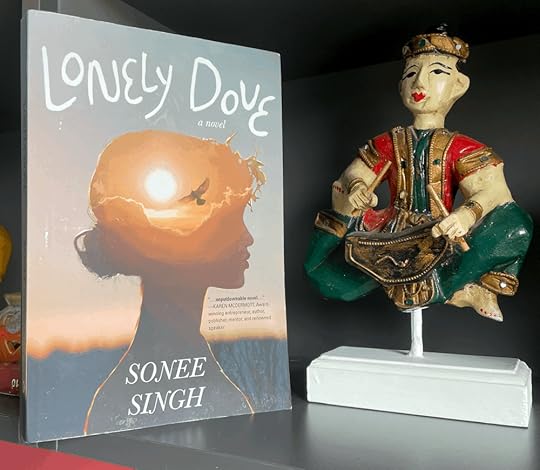
Writing has always been part of my life in some way shape or form in whatever job or occupation I've had. It wasn’t necessarily artistic,
as I was writing promotional material, training manuals, treatment menu descriptions, marketing copy, and business plans. At the time I started Lonely Dove, I was a wellness coach, and I regularly posted articles on health and wellness.
Lonely Dove was one of the first manuscripts I started writing and I began working on it six years ago, in January of 2018. The book was published four and a half years later, in September of 2022.
My first lesson was recognizing that when I found my passion—writing—it didn’t feel like work at all.
I loved writing, but what I really wanted to do was creative writing, not just non-fiction. The novel was born out of a desire to explore stories I held within. I started writing the novel on the side. I had the idea for the story in my head for a long time and had attempted many times to write portions of Lonely Dove. I had written short stories but nothing too long or complete.
When I began working on the manuscript in earnest, I didn't know if I had it in me to finish a novel. It turned out I enjoyed working on the novel so much, that soon enough, I spent more time writing my book than doing my wellness coaching work.
My second lesson was accepting that if something was important to me, I had to give it my time and attention.
It takes a lot of effort to write a novel and I didn't know if I was going to be able to write it all. It turns out I had it in me, but it took a lot of dedication. The articles I had written until then were 800 to 1,200 words, a short story was about 5,000 words, but a novel is at least 80,000 words. Lonely Dove is nearly 87,000 words long. I learned I had to be diligent, not just in making time for writing, but in minding the style. I had to make sure the storyline had continuity and consistency, and that the plot and characters went through an arc. When I did, I knew it needed to be improved.
My third lesson was knowing that I couldn’t do it alone.
I wanted to know if there was value to the story and if it was worth sharing. But, I wasn’t qualified. I have many degrees and certifications but none are in writing. I looked for help, and it turned out to be a long process of learning, editing, and rewriting.
Poetry was simpler because poems are a series of moments I collect under a theme. Yes, they need editing, but not in the same way. There doesn’t need to be continuity and consistency from page to page. My poetry was published quite quickly. One thing after another just fell into place.
It took longer with my first novel because I had so much to learn. I worked with a writing coach and five editors, each at a different stage of my writing process. I had to continue finding new editors because as I developed the story I knew I needed more and more help to get it to be the best version I could write.
My fourth lesson was better understanding my writing style.
I had to discover my style of writing. In the industry, I’m known as a pantser as opposed to a plotter. Some people are hybrids, and with my second novel, Can You Be, I had some of the story plotted out because it started as a short story, but the rest I figured out as I wrote.
Some writers plan out their whole novel before they start writing, and they know what the character is going to do, where they're going to go, what's going to happen to them, and how the ending is. For me, it was more intuitive. It wasn’t until I wrote Lonely Dove that I took my characters on a certain path versus another path. I got a general idea of who the characters were, what their personality was like, and a couple of elements of their journey, but the rest came to me as I wrote.
Editors pointed out I over-wrote and I had to go back to delete. Sentences, paragraphs, and even chapters got cut out during editing.
I later learned there was value in what was seemingly a shortcoming. In overwriting, I became familiar with my characters. I got to know their personalities, and how they behaved and acted. I understood how they reacted in different scenarios, like why they held something back in some situations and why they opened their hearts in other circumstances. I also learned how they built relationships with other characters, and why they bonded with one character but not with another.
Looking back, my takeaways are the following:
It’s important to find your passion and to give yourself permission to follow it
If something is valuable to you, give it your time and attention
When you need it, ask for help
Learn about yourself, what works for you, and what doesn’t
I encourage you to discover and follow your passions. What do you yearn to do? What do you make time for? Dedicate time to it and you may be surprised at the results.
December 15, 2023
Visibility is Scary but It Changed Me

The first time I called myself a writer out loud was on August 14, 2019, and by then, I’d already been writing daily for a couple of years.
Yet I hadn’t shared this much and at the time, uttering those words was one of the hardest yet most transformative experiences in my short writing career. It was nerve racking yet necessary.
I did this as part of a Visibility Challenge with four other amazing women. I had signed up for the challenge, knowing that I needed a push to feel more comfortable with putting myself out there. At the end of the challenge, we each had to do Facebook Live, granted, only within our private group. It was the first time I’d ever taken a video of myself speaking.
I woke up early and prepared a special breakfast to mark the occasion. I was meant to give myself enough time to get ready at a leisurely pace, but nerves got the best of me, I overestimated how much time I had at my disposal, and by the time I got ready it was two minutes before the session was meant to begin. I’d had a hard time shaking off my nerves and now I grew warmer and sweatier than I already was, but I had no choice. I had to go with it.
I started the session well. I was animated and engaged. I shared my story without having to refer to the notes I’d prepared. I talked about my journey becoming a writer and why it was so important to me. It seemed like all was going well, even though I wiped away sweat beads accumulating on my upper lip. Without realizing it, I completed the FB live holding a tissue in my fist.
When reached the point in my story where I shared how I felt when I completed the first draft of my first novel, Lonely Dove, I started to tear up. I tried to compose myself but the emotion swallowed me whole. I had cried when I had practiced the session and I thought I had squeezed out all the tears, but there was something quite powerful about sharing my story to a live audience, no matter how small, instead of to the four walls of my apartment. Before long, tears were flowing non-stop.
I managed to get through the rest of the content, but there’s a lot that I left out. I had wanted to share information about my book, and provide a summary or introduction, but I couldn’t. Instead, I finished by staying, “I am a writer.”
Later I got feedback that it was a powerful finish. I am a writer, and it was the first time I had acknowledged it out loud. By then, I was already writing every single day, but I had kept my practice private.
When I finished the Facebook live, my first impulse was to apologize for crying, and I did. Then I rationalized that at least only four people witnessed it. Finally I realized it didn’t matter how many people would have seen me cry.
It was a good exercise for me. I showed emotion—something I don’t do readily. Most importantly, I showed my vulnerability, which is harder still. I was open about what I feel passionately about.
Looking back, I think it was beautiful. It is a big thing for me to admit I feel strongly about something and to cry openly. I am known for going with the flow, being adaptable, having a positive outlook, smiling, and being even-keeled. Outside of that, I rarely show emotion. It’s not that I don’t feel it, but only those who know me deeply or well, experience my full range of emotions.
I was touched by the reactions of the four ladies who were my audience. They were touched by the emotion I shared. I was touched more.
To cry was an accomplishment. To cry and overcome the guilt and shame associated with it was an even bigger accomplishment. I have cried some more since that live session. It turns out there are more emotion I need to release.
It is scary to step into a public forum and dare to be seen. We’re afraid of others’ judgments and of our own. But at the same time, there is nothing more liberating than granting yourself the privilege of showing who you really are.
November 19, 2023
I am a Poet, Yet I Struggle Answering: What Is Poetry?
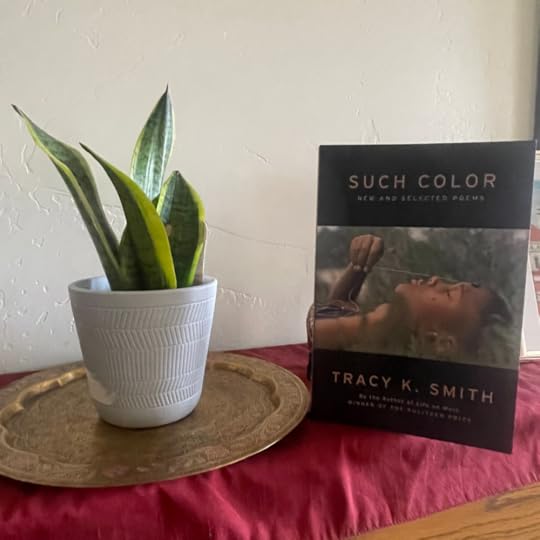
I listen to other authors and writers speak and share their stories and experiences because I am inspired when I learn from them. Tracy K. Smith was particularly significant for me.
She was the 22nd Poet Laureate for the United States, and served from 2017 to 2019. From listening to her speak at the Sun Valley Writers Conference (SVWC) the weekend of July 22nd, 2023, I learned I am a poet. Yet, I still have so much to learn and develop. When I “grow” up, I aspire to be like her.
Tracy K. Smith’s session at the SVWC conference was about poetry, defining poetry. Smith quoted renowned American poet, Lucie Brock Brood, who said poetry is a proposition beyond logic.
Tracy K Smith said poetry is a participation in a part of creation, and it serves to spark senses, sensations, memories, experiences, meaning, and the forgotten sense of self, and it helps us aspire to become someone. She said, “Poems slow down time.” They connect you with your soul.
That really struck a chord with me. A poem is a co-creation. It is a coming together of a part of your soul with the soul of the universe by bringing consciousness or awareness to something, to a moment. As a writer, you share part of your experience, and when people read it, they superimpose their own story, family, meaning, and experience into your story. They help us explore the known and the unknown parts of ourselves.
Many readers have told me that when reading my poetry they feel as if I am speaking directly to them. When I write poetry, I think of no one but myself. I find it fascinating that a reader interprets my words in such a personal way.
This is something Smith also mentioned, as well as several other authors of fiction and non-fiction at the conference, and I feel it’s because it’s true of any writing. In a piece of writing, there are two parts that come together to make the experience. One is the writer who shares a story, an anecdote, a thought, an opinion, or something of their imagination. The second is the reader who incorporates their story, anecdote, thought, opinion, and imagination. Every experience is unique as there are no two readers who are the same, thus every single interpretation of the writing will be different for every person.
Tracy K Smith said that poetry may present a connection with the otherworldly and with the divine. For me, poetry awakened in my connection to the divine. As I pursued my Doctor of Divinity degree, poetry was an intrinsic part of my self-discovery. I even included poems in my dissertation.
Writing poems helped me connect with the outside world and with my inner world. When looking at the outer world, the best approach is to study the senses. What I see, what I smell, what I touch, what I taste, what I hear, what I sense. Studying my inner world was the key for me to acknowledge and understand my emotions.
After all this, I’ve come to the conclusion that poetry is any form of capturing a moment, from your perspective, and sharing it with the world.
October 17, 2023
How Healing Has Helped My Writing
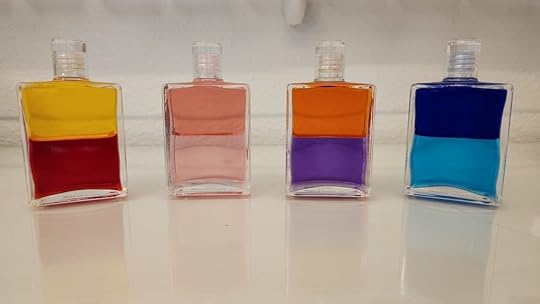
I have been focused on my healing journey for the last six years, and writing has been part of that journey.
Writing and healing have been integral to how I have uncovered, gotten to know, understood, accepted, and come to love myself. Writing has benefited my healing and healing has benefited my writing.
The best way to illustrate this is by telling you about the Aura-Soma session I had recently. Aura-Soma provides a collection of products made out of crystals, essential oils, plants, colors, and other substances. The company only uses organic and biodynamic ingredients, and the purpose of their products is to balance the energetic system.
Joanne Magdaleno is the healer I have been working with for the last few months, although most of the work we’ve done together involves obsidians, which is a separate topic. I did an Aura-Soma reading with her when we first started working together almost a year ago, and I completed a second Aura-Soma reading a couple of months ago.
As part of that reading, Joanne asked me to select four bottles within the Equilibrium Aura-Soma family. Each of these bottles has two colors, one on top and another at the bottom, as depicted in the image above. I selected the four above bottles, and Joanne conducted a reading and took the above photograph.
The first time I had an Aura-Soma reading with her, I didn’t pay as much attention because, at the time, I didn’t know what I was getting into. Two months ago, having already felt the benefits of the products, I took copious notes.
I will not take you through the whole reading, and only explain the first bottle I selected to make my point. The top color in the Equilibrium bottle represents the conscious and the bottom color represents the unconscious. The first bottle I chose had yellow on top and red on the bottom. Mixing them shows what you’re trying to manifest or bring to life. Mixing these colors results in orange.
Yellow represents joy. It’s linked to the third chakra and represents an opportunity to awaken through joy. I’m conscious of this; I am aware of the light and joy I bring to the people close to me. Red represents grounded energy. It’s linked to the first chakra, and it’s what I carry in my unconscious. Survival comes from red, as well as fear.
Together, they represent having an opportunity to manifest joy and let go of fear to open to opportunities that will help me grow. Mixing them raises the question: How do I use the red energies to bring to life yellow energies? Orange, then, the wisdom gained from mixing red and yellow, is the potential to create, the potential to bring a project to life. It’s linked to the second chakra.
The reading Joanne conducted felt to me like a true depiction of my most recent healing experiences. I have had some type of illness for the past several years. Nothing has been serious but illness is constant, and being ill made me realize I have been selling myself short by being afraid to show who I truly am. This fear, now that I’m conscious of it, is pushing me to fulfill a higher purpose.
I’m using my struggle to change the way I see myself. To heal, I am using my fear as a strength. I am drawing from my fear (red) and embracing my sense of self (yellow), which create a sense of stability (red) to manifest and bring about change or bring something to life (orange).
If you’ve been watching my updates recently, you’ll notice I updated my logo and my author identity, and that was part of a process of embracing different aspects of who I am.
Oddly, it also felt like a reflection of the journey some of my protagonists have gone through in my novels. It was interesting to have a personal reflection and a reflection on my writing, although I wasn’t conscious of this synchronicity until the recent session with Joanne. I must have unconsciously been uncovering within my characters the deeper learning of the experiences I was having. In my novels, my protagonists are on a journey of self-discovery where they learn to embrace who they are, confront their fears, and create the life they want for themselves.
We all have the same opportunities. Not only can healing help us embrace aspects of ourselves we have kept subdued, but we can all awaken through feeling joy. Joy inspires creativity, happiness, spontaneity, and seeing the positive. Having compassion toward ourselves and facing our fears helps us to feel grounded, and that stability enables us be who we truly are. Ultimately, it leads us to feel at peace with ourselves.
I am continuing on my healing journey and cannot wait to see what else I uncover.
September 17, 2023
A Hospital Scene…Out of the Blue

In June I attended Joan Dempsey’s Gutsy Great Novelist Retreat, and she had all of us writers who were in attendance come up with a scene for our work-in-progress that incorporated the same elements in a setting.
In other words, we were all given the same setting: a hospital room and items within the room that needed to be included in the scene. But, we had to write it to fit our own characters. I am working on a historical fiction book, and the main characters are Chandan and Devi.
I was surprised that even though we were all given the same setting and objects, everyone’s story was completely different. Some were thrillers, others science fiction, and still others magical realism, yet they were all unique. It’s amazing how we can take the same elements and come up with scenarios that are unique to who we are and the story we are relaying.
Here is my scene:
Chandan lay on a plastic-frame hospital bed on that evening in early July. It wouldn’t be the last day of his life and but he wasn’t aware. He still had seven months to live, but as a cool breeze swept through the room, he thought we would soon pass.
He only wished Devi was there with him to witness his final moments, but the hardback visitor chair was empty. Then again, he had missed hers, so perhaps this was appropriate. She had died on her own and so would he.
A pastel print hung on the wall. It showed cows standing in a grassy field, with sun and mountains beyond. Part of the image was foreign to him, as Chandan hadn’t seen mountains in his life, but the fields and cows reminded him of his village, and oddly, he felt connected to home.
He reached for the plastic cup of water on the nightstand, and when he found the cup empty, he filled it with the warm water from the plastic pitcher next to it. Thankfully, by 7:30 pm, the usual bone drying July heat had dissipated, and Chandan didn’t mind that the water wasn’t ice cold.
He wouldn’t have known it was 7:30 pm if it hadn’t been for the small clock radio on the nightstand. The world outside, which he viewed from the one large window in the room, was filled with vivid summer colors. They danced to his delight, and for the first time, he understood what Devi must have felt when she had delighted in the colorful textiles she so loved. Green from the lush trees jumped out at him, tiny lilac and yellow flowers shimmered in the grass, and what seemed like blue mountains in the distance sparkled in his eyes. The golden hue from the late sun gave the view a warm touch. God, he missed his Devi so much.
Her face in his mind changed his mood. He had woken up in the hospital feeling sorry for himself, and now he was excited at the prospect of meeting Devi in the afterlife.
The room took on a different light. The black flat-screen TV that had hung menacingly close to his bed now seemed to float graciously in the air. The fuchsia pink trash can with a neon green plastic, which had at first been obnoxious to his eyes, now reminded him of the delicate smooth silk scarf Devi had cherished.
I’m going to try to incorporate this scene in some way in the novel. I’m certain I’ll have to modify it to make if fit to the time period I’m writing in, but I’m so grateful to Joan and the exercise she provided us as this has given me more tools to play around with as a writer.
August 23, 2023
Why I Loved Writing “Can You Be”
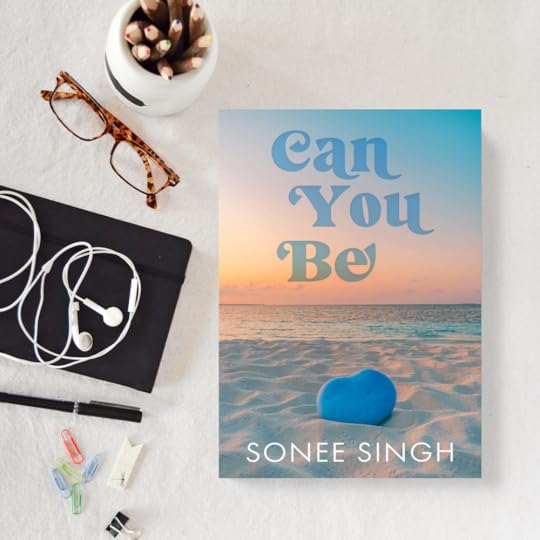
My latest novel, Can You Be, was just released! It’s my second novel and overall, my fifth book. I loved writing Can You Be.
It started as a short story called “The Box,” and I kept that name for a long time. I was lucky that a friend of mine and later an editor who read the short story version recommended I lengthen it into a novel. I did that last year, and the result was this book.
The description at the back says:
Naina’s life is as it has always been. She lives in a self-imposed sheltered manner in Charleston, South Carolina, yet wants nothing more than to have the support of friends and family. She is too afraid to put herself out there, having been hurt so much in the past. Her routines give her a sense of safety…until an early August morning, when Naina receives a box. It has no information about its sender and it is left on her doorstep. A mysterious man shows up at her work asking her about it.
Everything begins to change after the arrival of the box, and Naina is presented with a chance to change her life, and to explore compassion, forgiveness, and believing in herself. She struggles to understand the power of connections and the potential of expanding her horizons. Naina’s journey is mystical and, in portions, it takes her through Stockholm, Helsinki, and the Baltics. Will this quest lead her to discover who she can be?
I loved writing it because this book is about relationships, it’s about self-compassion, it’s about believing in yourself, it’s about connection, and it’s about expanding your horizons.
At its heart, the book explores the notion of being: can you be? Is it about being alive? What does it mean to be alive? Is being a profession? Can you be something? Or is it about learning to be at ease with yourself? Can you (just) be?
I invite you to read Can You Be.
July 17, 2023
How I Aim for Balance
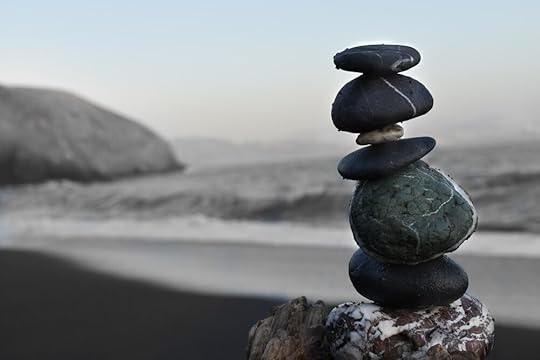
For most of my life, I have been a workaholic, and my health has suffered as a result. As I am writing this, I have rock-hard shoulders and a stiff neck,
and I’m reminded that I need to take a step back and give myself a break.
The last time I suffered a major health issue was in 2017, when I ended up in the hospital, and even, then, it took me a while to recognize that I needed a new approach. I went from working up to sixteen hours a day to working no more than seven.
I have had to set the intention of working less, which is hard for me. In the last two years, I went from an aspiring author to a published author. I have three books of poetry through MMH Press and my first novel was published last year through Koehler Books.
I have gotten better at managing work/life balance in the last few years. I have learned, the hard way, that less is more. The more rested I feel, the more productive I am when I work. The more replenished I feel, the more inspired I am in my work. The more centered and calm I get, the more focused I am when I work. The more I spend time doing things for myself, the more energized I feel to work.
The journey of me becoming a writer and eventually an author is one of self-discovery, self-acceptance, and for me allowing to express my authentic self. I had wanted to be a writer since I was eight, but I didn’t allow myself to do so because I thought I would disappoint those around me. It took me getting seriously ill to follow the true calling of my soul and finally dedicate my time to what I have always wanted to do.
But I have put a lot of pressure on myself because I often feel that unless I cross out items on my to-do list, I am not being productive, which is far from the truth. It’s a perception of myself that I work on letting go.
Meditation helps. I meditate every day, even if it’s just for a couple of minutes, although if I have more time, I do it for twenty to thirty minutes. Meditation helps to calm my mind, get present, and break away from the perfectionist and over-achiever patterns I gravitate to.
It has been an ongoing process to learn this, and I have peeled several layers of myself to unravel why it is that I used to push myself so much to work. To simplify, I thought I would only be valued if I could prove how much I could accomplish. Healing those feelings of perfectionism and realizing that when I do less, I allow for space to do things that enable me to be more myself, I feel more at peace, and ultimately this helps me to have a more balanced life. I am, however, a work in progress, and continuously seek to maintain that balance.
What do you do to aim for balance?
June 20, 2023
Embolden is ONE!
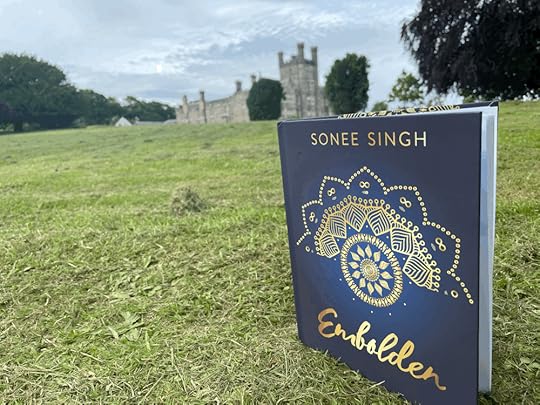
Embolden, the third and final book in my Soul-Seeker Collection, is ONE year old.
It launched at Crom Castle, where this photo was taken.
In honor of this Book Birthday, I’m sharing part of the journey I took when writing these poems, as the collection reflects my personal experiences.
Embody, book one, was about exploring my feelings and allowing poetry to come to me. I hadn’t been a poet prior to writing the collection. Embody captured my internal journey, particularly my emotions and their physicality, and thus, it’s about chakras.
Embrace, book two, was about accepting where I was in life, including accepting I am a poet. I was going through a lot of life changes at the time, and in that stage of flux, I recognized nothing lasts forever. Embrace is about cycles.
By the time I wrote Embolden, I had consciously decided to bring poetry into my writing. The poems in Embolden are about honoring my creativity and letting it flow.
Embolden is about signs and our place in the universe. The poetry has a lot of symbolism because at the time, I felt nature, objects, numbers, and other items were communicating with me, and it inspired me. Embolden is about moving beyond what we’ve experienced. If we allow ourselves to see we are connected, we realize everything happens in support of us. Negative and positive experiences are part and parcel of our journey. We realize our experiences are connected to the universe. In winter, we tend to be introspective. In spring, we work on new projects. Summers are active and falls are about preparing for change.
Many poems in Embolden focus on numbers, which carry meaning. For instance, palindromes are dates or words that are read the same backward and forward. Palindrome dates present opportunities for us to overcome or transcend emotions. Five is about shift and change. When I see 5:55, I know it’s a sign there's a shift in the world, change is coming, and I’m in the process of evolving.
Through writing the Soul-Seeker collection, I learned to welcome poetry into my life, and I write it when it comes to me. It’s not the same with novels. I can write fiction at set times. But with poetry, I can go days or even weeks without writing a poem. But once I get hit with a spark of creativity, I have to write it down. I don’t know when that will happen, so I’m always ready to give it time and energy, and allow it to flow.
I carry a notebook with me most of the time, and if I don't have a notebook, I'll use any piece of paper I can find. I've written poems on brochures, ticket stubs, napkins, and coasters. As a last resort, I use my phone, although I prefer to write poems by hand, and only type them when I edit. Poems have come to me while I'm driving or when I'm in the shower. I can't write them at that time, but I keep the seed with me until I have the chance to write it down.
There are no tables of contents in the Soul-Seeker Collection. You can read any book in one sitting. You can read it sequentially over a period of time. You can also open any book to any page, and have that be your poem for the moment. The poem will speak to your soul, like a message for the day.



